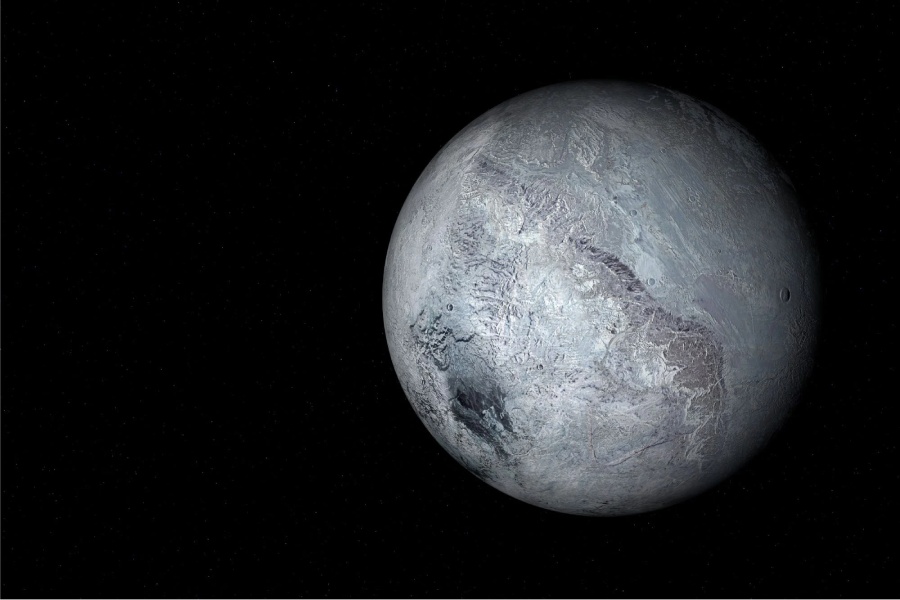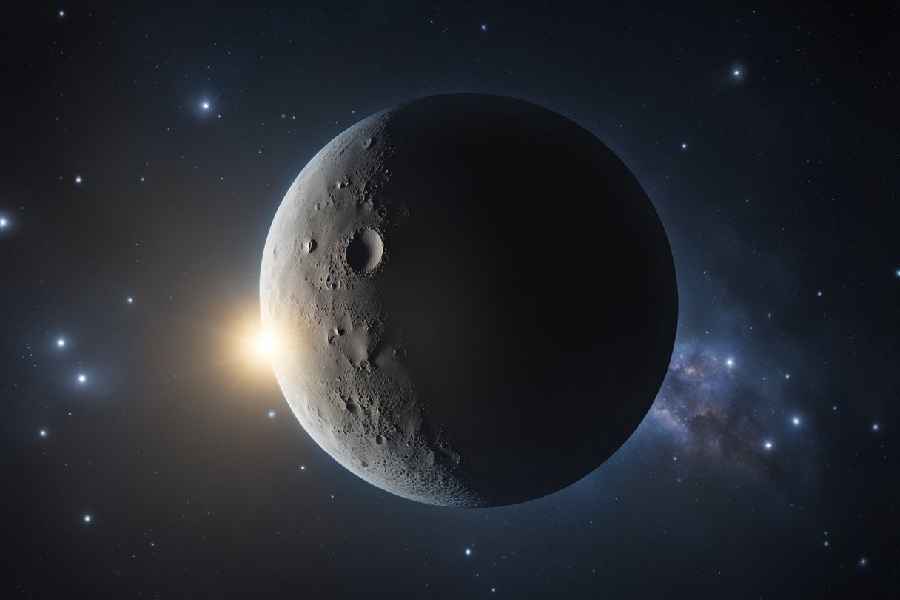In the dark outer fringes of our Solar System lurks a dwarf planet named Eris. First glimpsed in 2003, this mysterious frozen world beyond Pluto raised startling revelations that challenged long-held notions of what truly constitutes a planet.
But despite being a massive dwarf planet, early astronomical observations struggled to accurately determine the true dimensions of the remote world Eris. How big is Eris?
Initial size estimates ranged over hundreds of kilometers while trying to determine the precise diameter of Eris, which orbits the Sun well over three times farther out than Pluto.
Understanding Eris’ true scale would help reveal key details about its composition, origins in the early Kuiper belt, and even potential for a subsurface ocean.
What challenges thwarted the first precise measurements of Eris’ size? How did uncertainties about its shape and orientation further complicate early efforts to calculate how big Eris is?
Join us in this quest as we uncover the true size of this dwarf planet near the outer edge of our Solar System.

How Big Is Eris?
How big is Eris? Eris, a dwarf planet in our Solar System, is about the same size as Pluto. It’s a bit smaller in diameter, around 1,445 ± 7 miles, making it one of the largest known objects in the Kuiper belt – a region of icy bodies beyond Neptune.
Eris gained attention for its discovery in 2005 and its role in the reclassification of Pluto from a planet to a dwarf planet. In simple terms, Eris is roughly the same size as Pluto, both being relatively small, icy worlds in the outer part of our Solar System.
Diameter and physical dimensions
Measurement of Eris’ diameter
Observing Eris from Earth poses challenges due to its small size and vast distance. Scientists estimate Eris’ diameter near 1,400 miles based on data so far.
Eris and Pluto’s estimates come with uncertainties. Better observations should refine knowledge of Eris’ true width.
Key physical characteristics
Eris seems to have an oblong, distorted shape rather than a sphere. It rotates very slowly – one Eris day lasts over 25 hours! This sluggish spin hints at a two-layer interior structure. Its surface mainly consists of frozen methane, nitrogen, and water ice.
These coat a rocky core making up most of Eris’ mass. Dwarf planet Eris remains mysterious, with much left to learn about its make-up through improved studies.
Methods used for size estimation
Astronomers mainly use occultation studies to deduce Eris’ size. These measure how much starlight tiny Eris blocks when passing in front. Scientists also monitor infrared wavelengths. They observe how much heat Eris gives off.
Comparing different observations provides diameter estimates. However, results depend heavily on accurate modeling of Eris’ orbit and predicting occultation times.
It is tricky to gauge Eris’ exact shape, orientation, and reflectivity. Its great distance makes Eris appear very small and faint. Intervening space matter distorts data.
Separating dim Eris from background sky items also hinders accurate measurement. The best occultation data require many perfect, widely spaced observations across Earth conducted simultaneously. These opportunities come rarely for incredibly distant Eris.
Comparison with Earth and Pluto
Recent data estimates Eris’s diameter at 1,445 ± 7 miles, significantly smaller than Earth yet among the largest known dwarf planets. Stretched across Earth, Eris would span part of Europe. While dwarfing asteroid belt objects, Eris holds merely 0.22% of the Earth’s mass.
Eris is now confirmed via direct measurement to be slightly smaller in size than fellow dwarf planet Pluto, which has a 1,476 ± 1.9 miles width. Though less voluminous than Pluto, Eris packs more mass into its modest frame.
The discovery of Eris played a pivotal role in Pluto’s dwarf planet redesignation in 2006, as both remote icy worlds possess structures distinct from the eight official planets. While Pluto remains the current record holder for the largest dwarf planet, Eris claims the title of the most massive dwarf planet identified to date in the Solar System’s outer realms.
Measurement challenges and refinements
Historical challenges in size estimation
Eris’ small apparent size and great distance posed obstacles for early size estimates. When discovered in 2003, Eris was barely detectable as a faint speck.
Picking it out from the crowded night sky took effort. Inaccurate assumptions about Eris also impacted initial measurements. Obtaining sharp images challenged early 2000s detectors. Data often suffered from scattered light distortion effects.
Modern data and technological advancements
Higher quality cameras and new analysis techniques help better extract Eris’ size. Space telescopes avert problems caused by Earth’s atmosphere.
New thermal and occultation data continue refining and confirming Eris’ diameter near 1,400 miles. The European Space Agency’s Gaia spacecraft contributes positional data to constrain measurement errors.

Eris Mass and Composition
Understanding Eris’ mass relative to other objects
Using its moon Dysnomia’s orbit, scientists calculated Eris has a mass of about 27% more than Pluto, even though Eris is slightly smaller in diameter.
Measurements indicate Eris has a density of 2.52 g/cm3 – substantially denser than Pluto’s density of around 2 g/cm3. This suggests unlike icy Pluto, Eris has an interior composition more abundant in rocky materials.
The higher density aligns with models predicting Eris consists of an inner rocky core surrounded by an ice-rich outer mantle closer in makeup to other icy bodies than Pluto’s interior structure and origins.
Significance of mass in planetary classification
An object’s diameter gets more attention in planet definitions. But understanding mass also matters. Mass indicates internal structure and formation.
Comparing Eris’ mass against expectations will inform improved dwarf planet models. Unexpected densities provoke questions enriching Kuiper belt formation theories.
Contributions to Eris’ gravitational influence
Eris is unlikely to gravitationally perturb nearby Kuiper belt objects much. Its low mass limits Eris’ gravitational reach. But tiny Eris moon Dysnomia does get tugged by its parent planet.
Observing Dysnomia’s orbit allows for calculating Eris’ mass. Eris interacts gravitationally with sister dwarf planet Sedna, but the effects are very gradual over thousands of years.
Gravity drops off strongly with distance. So very massive objects like Jupiter have far-reaching effects. Dwarf planets are much less massive, so they disturb little beyond their moons.
Gathering precise mass helps map an object’s gravitational dominance and influence. Uncertainties in Eris’ orientation and non-spherical shape introduce additional errors in current mass calculations.
Composition and physical characteristics
Insights into Eris’ surface and surface features
Eris should have a very cold, icy surface with temperatures near -400°F. Photographs from Earth and Hubble reveal little detail on petite Eris besides vague light and dark patches. Its distance makes surface resolution very difficult right now.
Even the best images so far capture no specific surface features on small Eris. Improved space telescopes will be needed to resolve surface structure in this incredibly remote, tiny world.
Probable composition and implications for its dimensions
Eris likely consists mostly of rock and ice. Models predict an outer layer of frozen water, methane, and nitrogen covering an inner rocky core, making up most of Eris’ mass. The thick ice mantle points to Eris having started cold and remained little changed, unlike closer dwarf planets with more complex interiors.
Size of Eris Compared to Planets in the Solar System
At roughly only 1,300 miles wide based on the best current measures, tiny Eris ranks much smaller than all major planets. For example, Eris would need over 120,000 more Erises to match Jupiter’s immense width.
Even dwarf planets Pluto and Ceres considerably outsize frozen little Eris. Compared to most Solar System orbited worlds, Eris fits squarely among the very smallest based on its estimated diameter.
Is Eris bigger than Pluto?
Eris remains categorized slightly narrower than fellow icy dwarf planet Pluto. But only by a small margin – less than 2% smaller diameter based on the most supported figures.
The two frosty dwarf worlds likely have comparable volumes, as the best observations indicate. Their similarity in size sparked debate around the definition of a planet when Eris was first spotted.
The realization that remote Eris and other Kuiper belt denizens rivaled Pluto in size contributed to the decision to reclassify Pluto as a dwarf planet in 2006, which neither quite qualified as a full planet.
But Eris and Pluto still stand as the largest worlds surveyed so far beyond Neptune. Their similar sizes reinforced arguments that Pluto should join Eris as a dwarf rather than a regular planet.
Conclusion
Exploring and determining exactly how big is Eris has challenged astronomers since its discovery. But over years of focused effort and analysis, estimates now place its diameter confidently at about 1,400 miles. That makes tiny Eris slightly smaller in size than its Kuiper belt companion, Pluto.
We hope examining the techniques and challenges behind pinning down an accurate measurement of how big Eris truly is has shed some light. It illustrates just how complex it can be to study these remarkably remote, icy worlds scattered so very far.
Eris pushes the limits of what our instruments can discern at such unfathomable distances. Still, more discoveries about dwarf planets surely await, even beyond Eris in the uncharted territories of our Solar System’s outermost physical frontiers.
